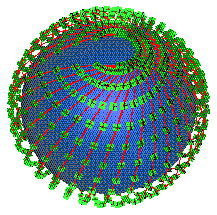|
The Teledesic Network |

The Teledesic system will provide global communication links via a constellation of 288 LEO spacecraft. The system will provide "fiber-optic like" links to customers around the world. The system will act as a network operator and will support communications ranging from high-quality voice channels to broadband channels supporting videoconferencing, interactive multimedia and real-time two-way digital data flow. Teledesic is backed by Microsoft Chairman Bill Gates and Craig McCaw, founder of McCaw Cellular Communications Inc. The system will use Ka-band to send and receive signals from users. Each satellite acts as a node in a large-scale packet-switching network. Service is planned to begin in 2002. Total cost of the project is estimated at $9 billion.
A Global, Broadband "Internet-in-the-Sky" The Teledesic Network is a high-capacity broadband network that combines the global coverage and low latency of a low-Earth-orbit (LEO) constellation of satellites, the flexibility and robustness of the Internet, and "fiber-like" Quality of Service (QOS). Essentially an "Internet-in-the-Sky," the Teledesic Network brings affordable access to interactive broadband communication to all areas of the Earth, including those areas that could not be served economically by any other means.
The Teledesic Network can serve as the access link between a user and a gateway into a terrestrial network, or as the means to link users or networks together. Covering nearly 100 percent of the Earth's population and 95 percent of the landmass, the Teledesic Network is designed to support millions of simultaneous users. Seamless Compatibility Geostationary satellite communications systems require changes to terrestrial network standards and protocols to accommodate their inherent high latency, a minimum half-second round-trip delay. Teledesic's objective is to meet current network standards rather than to change them. By using fiber-optics as the guideline for service quality, the Teledesic Network is designed for compatibility with applications that are based on today's and tomorrow's protocols. This places stringent requirements on the system design, including low latency, low error rates, high service availability, and flexible, broadband capacity - all characteristics of fiber.
The Teledesic Network consists of a ground segment (terminals, network gateways and network operations and control systems) and a space segment (the satellite-based switch network that provides the communication links among terminals). Terminals are the edge of the Teledesic Network and provide the interface both between the satellite network and the terrestrial end-users and networks. They perform the translation between the Teledesic Network's internal protocols and the standard protocols of the terrestrial world, thus isolating the satellite-based core network from complexity and change.
Teledesic terminals communicate directly with the satellite network and support a wide range of data rates. The terminals also interface with a wide range of standard network protocols, including IP, ISDN, ATM and others. Although optimized for service to fixed-site terminals, the Teledesic Network is able to serve transportable and mobile terminals, such as those for maritime and aviation applications.
Most users will have two-way connections that provide up to 64Mbps on the downlink and up to 2 Mbps on the uplink. Broadband terminals will offer 64 Mbps of two-way capacity. This represents access speeds up to 2,000 times faster than today's standard analog modems.
The ability to handle multiple channel rates, protocols and service priorities provides the flexibility to support a wide range of applications including the Internet, corporate intranets, multimedia communication, LAN interconnect, wireless backhaul, etc. In fact, flexibility is a critical network feature, since many of the applications and protocols Teledesic will serve in the future have not yet been conceived.
| Send comments to webmaster Copyright © 1997 Derek Mc Donnell. All Rights Reserved. Last updated 07-Apr-1998. |
 |